Program Accessibility
For the purposes of evaluating accessibility, a "program" is an activity in which people may participate. Basically, the program is the reason a person visits an area and may include opportunities such as:
-
Camping in a campground
-
Viewing the scenery at an overlook (figure 4)
-
Swimming at a beach
-
Enjoying solitude in the wilderness
-
Gathering information at a visitor center
-
Learning about an area on an interpretive trail
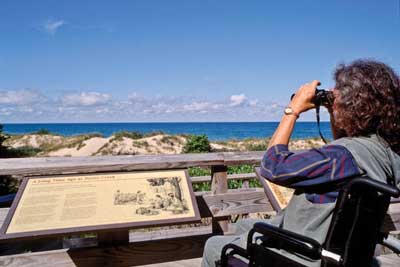
Figure 4—Interpretation is for everyone. Signs must be placed so that everyone can see and understand them.
The 1994 USDA regulations—7 CFR 15e http://www.access.gpo.gov/nara/cfr/waisidx_03/7cfr15e_03.html and 7 CFR 15b http://www.access.gpo.gov/nara/cfr/waisidx_03/7cfr15b_03.html govern USDA implementation of Section 504 of the Rehabilitation Act. They prescribe the requirements for ensuring access to programs.
If a program is provided inside a building or structure, everyone must be able to enter the facility to participate in the program. All facilities need to be constructed according to the applicable accessibility guidelines. Even historic structures are required to be as accessible as can be accomplished without destroying the historic significance of the structure. Unfortunately, some historic structures are not yet accessible, and a few cannot be made accessible without destroying their historic integrity. If a facility is not accessible, relocate the program or provide it in another manner (an alternative program). Any alternative program must allow everyone to participate together. Separate segregated programs just for people with disabilities aren't permitted. For example, if an evening program at a campground previously has been held in an amphitheater that isn't accessible, move the program to an accessible location until the amphitheater is accessible.
Under Section 504 of the Rehabilitation Act and 7 CFR 15, access to programs that don't depend on constructed facilities also are required to provide equal opportunity to all. People with disabilities may not be denied the opportunity to participate in a program if they meet the criteria to participate and their participation doesn't fundamentally alter the program. All participants must meet the essential eligibility criteria for the program and abide by any restrictions for that program in that area, including those of the forest land management plan. While all people are to have an equal opportunity to participate in programs and to strive to gain the same benefits offered by those programs, no guarantee of success is required.
The laws require equal opportunity; they don't require exceptional opportunity. For example, roads, trails, or other areas on national forests and grasslands that are not designated for motorized vehicle use under a forest travel management plan are closed to all motorized vehicles, including those used by people with disabilities.
Access to programs must be viewed through the lens of the entire program, not through the eyes of an individual. Access to the program is to be provided so long as doing so doesn't fundamentally alter the program. That is, providing access doesn't change the primary functions of the program. Allowing motor vehicles in a nonmotorized [sic] area would be a fundamental alteration of the recreation program for that area.
"Reasonable accommodation" does not apply to access to programs. Reasonable accommodation only applies in employment and involves making the modifications or adjustments to a job or the work environment so a specific qualified applicant or employee with a disability can participate in the application process or perform essential job functions. It does not apply to programs under Federal agencies, including recreation facilities and trails.
Questions often arise concerning the use of wheelchairs or other mobility devices in areas that restrict or prohibit mechanical devices or motorized vehicle use. As clarified in Title V, Section 508(c), the legal definition of a wheelchair is:
A device designed solely for use by a mobility–impaired person for locomotion that is suitable for use in an indoor pedestrian area
This is a two-part definition. "Designed solely to be used by a mobility-impaired person for locomotion" means that the wheelchair was originally designed and manufactured solely to be used for mobility by a person with a disability. The aftermarket retrofit of a motorized unit to make it usable by a person with a disability does not meet this part of the definition. The second part of the definition requires the device to be "suitable for use in an indoor pedestrian area" (figure 5). This means usable inside a home, courthouse, or other indoor pedestrian area, such as the food court of a mall.
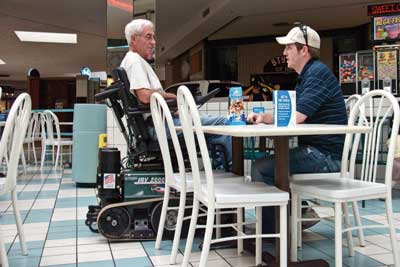
Figure 5—To meet the definition of a wheelchair, a device must be suitable for use in an indoor pedestrian area, such as this food court where two friends take a break from shopping. Like many wheelchairs, the device shown here also is useful for outdoor recreation, as shown in figure 11. Photo credit: Trac About, Inc., Newton, KS
The device must meet both parts of this definition in order for it to qualify as a wheelchair. Figures 6 through 11 show six examples of devices that meet the definition; figures 12 and 13 show two examples that do not.
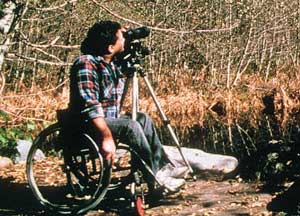
Figure 6
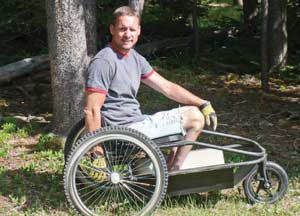
Figure 7—Photo credit: Axess Outdoors, Great Falls, MT
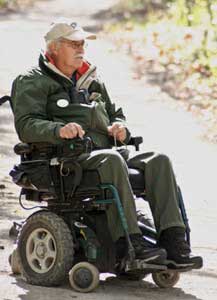
Figure 8
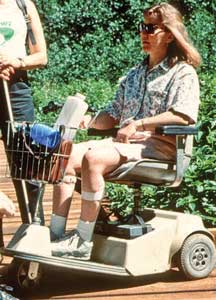
Figure 9
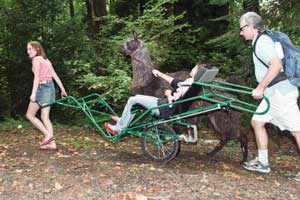
Figure 10
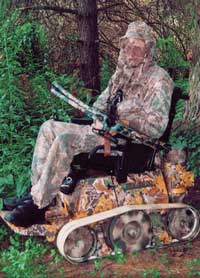
Figure 11—Photo credit: Trac About, Inc., Newton, KS
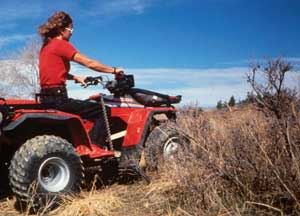
Figure 12
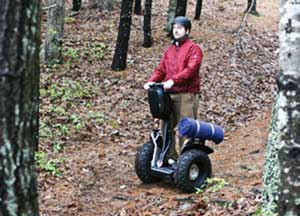
Figure 13
A person whose disability requires use of a wheelchair or mobility device may use a wheelchair or mobility device that meets both parts of the definition in the preceding paragraph anywhere foot travel is permitted in the National Forest System, in accordance with Title V, Section 508(c) of ADA; 36 CFR 212.1; and FSM 2353.05 and FSM 2320.05. Wheelchairs or mobility devices, including battery-powered wheelchairs that meet both parts of the definition, aren't categorized as motor vehicles or mechanical devices.
To determine whether a device meets the definition of a wheelchair, evaluate it against the two parts of the definition. Ask yourself the following questions:
1. Was the device designed solely for mobility by a person with a disability?
-
If "no," the device doesn't meet the definition and doesn't qualify for use as a wheelchair.
-
If "yes," ask the second question.
2. Is it suitable for use in an indoor pedestrian area? Consider whether it could be used in a mall, courthouse, or similar area without the security personnel directing the user to leave.
-
If "no," the device doesn't meet the definition and doesn't qualify for use as a wheelchair.
If the answer to both questions is "yes," the device meets the definition of a wheelchair or mobility device and may be used wherever foot travel is allowed. Some devices that don't meet both parts of the definition (see figures 12 and 13) are useful tools for some people with disabilities to move about in the outdoor environment, but they must follow the requirements for the appropriate class of motor vehicle. A "Motor Vehicle Use Map" that shows routes (roads and trails) and areas designated as open to motorized travel with allowed uses identified by vehicle class is available at national forest and national grassland offices. These maps also may be available through each forest or grassland's Web site http://www.fs.fed.us/ or through the National Forest Store Web site http://www.fs.fed.us/recreation/nationalforeststore/. Visitors can check the "Motor Vehicle Use Map" to learn where they may use devices that don't meet the definition.

User Comments/Questions
Add Comment/Question